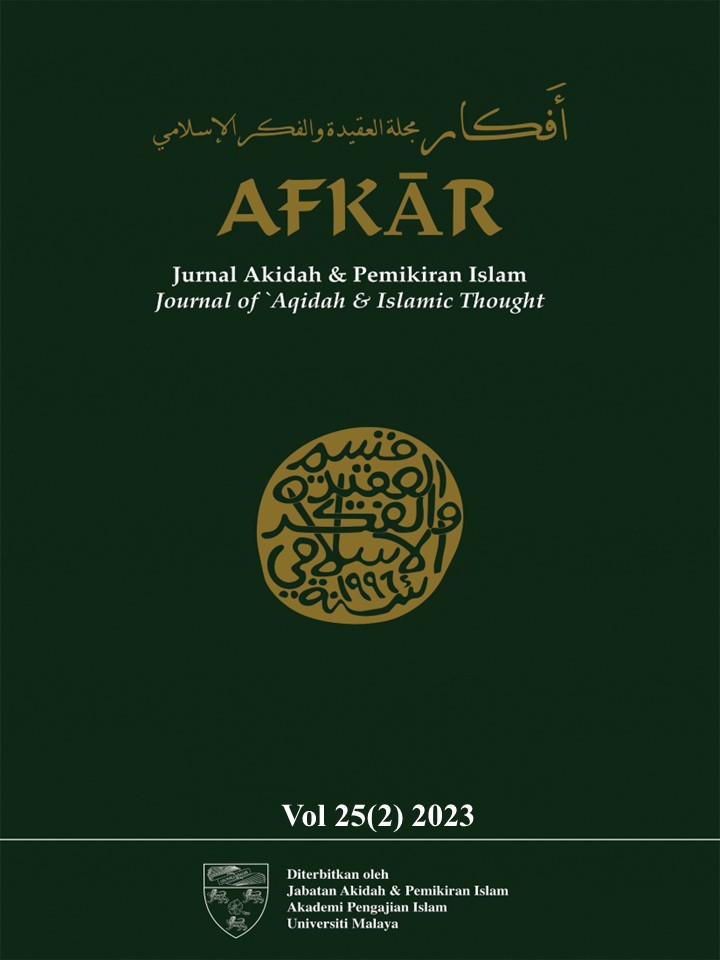Analisa Perumusan Konsep Ketuhanan Menurut Perspektif Thomas Beighton (1790-1844) Dalam Karya Inilah Kunci Pengempar (1841) Analysis of the Formulation of the Concept of Divinity from Thomas Beighton’s (1790-1844) Perspective in the Work Inilah Kunci Pengempar (1841)
Main Article Content
Abstract
Writing and printing are among the fields pioneered by the London Missionary Society (LMS) missionaries since their arrival in the Straits Settlements at the beginning of the 19th century AD. Thomas Beighton (1790-1844) was involved in this role, particularly within the Malay Muslim community of Penang. This required from Beighton, a mastery of the Malay language and Jawi script, which enabled him to produce a large number of works in that language. Therefore, this study which uses textual content analysis will concentrate on one of Beighton’s works dealing with the concept of divinity entitled, Inilah Kunci Pengempar (This is the Centrifugal’s Key), published in Penang in 1841. Through this work, Beighton has used a metaphysical approach in his writing to spread Christianity in the country. As a result, Beighton was discovered attempting to apply the concept of divinity based on the concept of trinity, which refers to God: the Father (Allah), Son of God (Jesus), and the Holy Spirit in all descriptions. This shows the efforts of the Christian missionaries at that time, who were enthusiastic about spreading the religion, including learning Arabic and comprehending certain concepts in both divine matters and Islamic law (the Shari‘ah).
Downloads
Article Details

This work is licensed under a Creative Commons Attribution-NonCommercial 4.0 International License.
References
Beighton, Thomas & Ince, John. 4 Mei 1820, Pulau Pinang, CWM-LMS Penang 1: 1805-23, fail 2 (A).
Beighton, Thomas. 5 Januari 1821, Pulau Pinang, CWM-LMS Penang 1: 1805-23, fail 3 (A).
Beighton, Thomas. 14 Jun 1820, Pulau Pinang, CWM-LMS Penang 1: 1805-23, fail 1 (A).
Beighton, Thomas. Surat kepada Rev. A. Tidman, 26 Jun 1843, Pulau Pinang, CWM-LMS Penang 4: 1836-1869, fail 6 (A).
Beighton, Thomas. Inilah Kunci Pengempar: Maka adalah Nama Kitāb Ini Kunci Pengempar, Ertinya Pembuka Rahsia yang Tersembunyi di dalam Perbendaharaan Mazhab Muslim ya’nī Islam dan Ketuhanan ‘Ain al-Qudsī telah Sudah Dizahirkan Adanya. Pulau Pinang: t.p., 1841.
Beighton, Mrs. Thomas (isteri). Surat kepada Rev. A. Tidman dan Rev. J. J. Freeman, 19 April 1844, Pulau Pinang, CWM-LMS Penang 4: 1836-1869, fail 6 (C).
Al-Attas, Syed Muhammad Naquib. Islam dan Sekularisme, terj. Khalif Muammar A. Haris. Kuala Lumpur: Pusat Pengajian Tinggi Islam, Sains dan Peradaban (RZS-CASIS) & Himpunan Keilmuan Muslim (HAKIM), 2020.
Al-Suyuti, Jalal al-Din ‘Abd al-Rahman ibn Abi Bakr. Al-Itqan fi ‘Ulum al-Qur’an. Arab Saudi: Markaz al-Dirasat al-Qur’aniyyah, t.t.
Bernardi, Jean De. “Emplacing a Network Religion in a World in Motion: Evangelical Christianity and the Brethren Movement in Penang.” Dalam Penang and Its Networks of Knowledge. Pulau Pinang: Areca Books, 2017: 83-114.
Burridge, Richard A. What Are the Gospels?: A Comparison with Graeco-Roman Biography. Texas: Baylor University Press, 2018.
Byrd, Cecil K. Percetakan Awal di Jajahan Selat 1806-58. terj. Saman, Mansor Ahmad. Kuala Lumpur: Dewan Bahasa dan Pustaka, 1991.
Fansuri, Hamzah. “Asrar al-‘Arifin,” naskhah Leiden, no. 7921. Dalam Al-Attas, Syed Muhammad Naquib. The Mysticism of Ḥamzah Fansuri. Kuala Lumpur: University of Malaya Press, 1970.
Ferdiansyah, Nizam, “Nur Muhammad dan Kosmologi Kaum Sufi,” Jawara – Majalah Kebudayaan, no. 12, 2017.
Gallop, Annabel Teh. “Indian Ocean Connections: Illuminated Islamic Manuscripts from Penang.” Dalam Penang and Its Networks of Knowledge. Pulau Pinang: Areca Books, 2017: 117-120.
Haji Salleh, Muhammad. “Pulau Pinang sebagai Pusat Ilmu dan Perkembangan Intelektual.” Dalam Sejarah Awal Pulau Pinang. Pulau Pinang: Penerbit Universiti Sains Malaysia, 2008.
Harun, Jelani & Merican, Azmi Iskandar. “Pengarang Manuskrip dan Permulaan Percetakan di Pulau Pinang”. Dalam Cakerawala Penulisan Sejarah dan Intelektualisme: Sumbangan Penulis-penulis di Pulau Pinang, ed. Sohaimi Abdul Aziz. Pulau Pinang: Penerbit Universiti Sains Malaysia, 2008: 2-14.
Hedley, Douglas. “Pantheism, Trinitarian Theism and the Idea of Unity: Reflections on the Christian Concept of God.” Religious Studies 32(1) (1996): 61-77.
Marmura, Michael E. Al-Ghazali: The Incoherence of the Philosophers: A Parallel English-Arabic Text Translated, Introduced, and Annotated. New York: Brigham Young University Press, 2000.
Mokhtar, Ahmad Najaa, et al. “Wahdah al-Wujud dalam Konteks Akidah dan Tasawuf di Malaysia.” Jurnal Ushuluddin Adab dan Dakwah 2(1) (2019), 82-93.
Raja, Sivachandralingam Sundara. “Konflik dan Kompromi antara Islam dan Kristian di Negeri-Negeri Selat dan Negeri-Negeri Melayu pada Abad ke-19.” Dalam Dastar Pendeta: Kumpulan Esei Sempena Persaraan Profesor Dr. Abdullah Zakaria Ghazali, ed. Abdul Rahman, Zulkarnain, Mohd Noor, Arba’iyah & Mohd Rus, Ahmad Kamal Ariffin. Kuala Lumpur: Jabatan Sejarah, Universiti Malaya, 2012: 437-451.
Santrac, Aleksandar S. “Three I Know not What: The Influence of Greek Philosophy on the Doctrine of Trinity.” In die Skriflig/ In Luce Verbi 47(1) (2013): 1-7.
Shah, Zulfiqar Ali. Anthropomorphic Depictions of God: The Concept of God in Judaic, Christian and Islamic Traditions, Representing the Unrepresentable. London/Washington: The International Institute of Islamic Thought, 2012.
Siti Nor Aisyah Ngadiran & Tatiana A. Denisova. “Metode Dakyah Kristian di Pulau Pinang Pada Abad ke-19: Kajian Terhadap Karya-Karya Terpilih Thomas Beighton (1790-1844).” AFKAR: Jurnal Akidah & Pemikiran Islam 22(2) 2020: 43-76.

